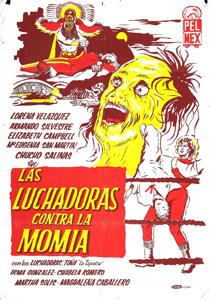To conjure Taggart (the immortal Slim Pickens’ character from “Blazing Saddles” (1974)): What in the wide, wide world of sports can “The Wrestling Women vs. the Aztec Mummy” (1964) possibly be about? It’s in the title: It’s a film about women (who wrestle) competing against a bandaged dead person of the Aztecan persuasion. But there’s more!
This Mexican production is also about archeologists jostling for treasure against the Japanese mafia – with both sides assisted by competing cadres of charismatic wrestling women. Then there’s a second female mummy (Xochitl, the lover of Tezomoc, the primary mummy). It’s slightly more complicated, honestly, than the title suggests. But it’s not a whole lot better than the title suggests, either. Then again, the title is pretty awesome.
Can a dwindling cadre of ambitious archeologists outfox a wily Japanese syndicate?
With a title as promising as “The Wrestling Women vs. the Aztec Mummy,” it’s easy to set one’s expectations unrealistically high. Honestly, the title overstates the film. And it is a bit misleading; I expected a hulking Aztec mummy to dominate the plot.

“The Wrestling Women vs. the Aztec Mummy” (1964)
Director: René Cardona
Writers: Guillermo Calderón, Alfredo Salazar
Stars: Lorena Velázquez, Armando Silvestre, Ramón Bugarini
But most of the opposition takes the form of a Japanese crime lord, Prince Fujiyata, his gang and his two Judo-master sisters. Aztec mummy Tezomoc doesn’t get any screen time until the last 20 minutes.
To be fair, as a mummy, Tezomoc is effective. He’s creepy. He can turn himself into a bat. He can shape-shift into a tarantula. His dark unblinking eyes are peeled wide. He moans weirdly. He’s spooky. You really can’t ask anything more from an Aztec mummy. He does what you’d expect of him, and he does it well.
Fujiyata (the Japanese gang lord) is also skillfully played. Ramón Bugarini squints in order to portray an Orientalism (and that’s a weak point). He can hypnotize his opponents to do his bidding (which comes in handy). He’s mean (which shouldn’t surprise anyone). Most importantly, he’s convincing (and that’s a high point).
The film-within-a-film technique
A good chunk of the film’s narrative unfolds in a frame-within-a-frame. The point-of-view shot is angled behind Fujiyata’s shoulder as he observes the goings-on in the protagonist’s flat, following their plans by means of his spy cam. It gives scenes (which otherwise might plod along) a certain voyeuristic urgency (and also, a certain low budget-ness). There’s a B-movie vibe that you cannot escape.
However, there is wrestling. Which you also can’t escape. Lots of really great staged wrestling. The film is worth it for the wrestling alone.
But back to the plot: An ancient codex identifies the location of a breastplate. The breastplate, in turn, contains a map to Aztec treasure. Half the codex is held by the archeologists, the other by Fujiyata’s gang. Each half is worthless without the other half.

Eventually, the competing teams recognize their stalemate and agree to settle their differences in the wrestling ring. Whomever wins gets the other half to the codex. Let the wrestling matches begin!
The wide, wide world of wrestling
The primary match – for the second half of the codex – pits Golden Ruby and Loretta Venus (and their traditional, virtuous, family-style style of wrestling) against the outsider-pair of Judo wrestlers (and their non-Mexican approach to combat). It’s a contest between tradition and current craze.
The film announces the match as a “sensational fight between members of the weaker sex.” Watch women beat up women. Salaciousness sells, I guess.
What’s missing from the film are strong heroics. Not a man-character, necessarily, but a woman with agency. Ruby and Venus, as protagonists, are nice enough; they exhibit strength and courage insofar as they rescue their men at several points, but they never rise above being cast as “the weaker sex.” As characters, they’re flat.
Truly, the only thing that distinguishes Ruby and Venus from one another is that one of them has a boyfriend. The other lacks a boyfriend. Otherwise, as far as I can tell, they’re the same character. But they’re loyal, intelligent and very good at wrestling, you have to give them that.
So, is it actually worth a view? Marginally. The best parts are the wrestling. Insofar as the film has a moral center, it’s in the women’s wrestling. “The Wrestling Women vs. the Aztec Mummy” is neither horror nor horrible. But it is watchable. You could do worse. You could, by way of example, watch “Incoming” (2024). (Hint: Don’t.)

